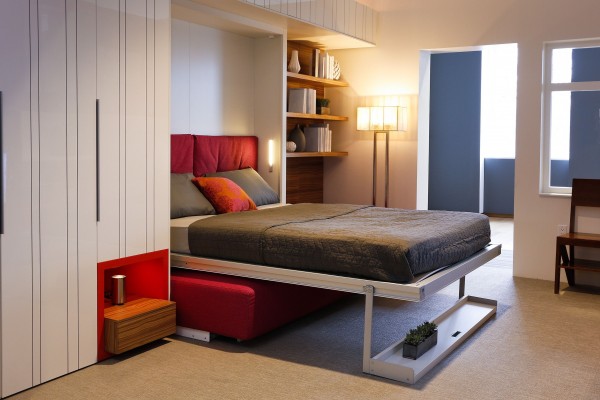
Lauren Meister is asking her fellow City Council members to consider creative options for dealing with West Hollywood’s shortage of affordable housing and the impact of the Ellis Act.
A proposal that will go before the Council at its Jan. 19 meeting asks city staffers to study the short- and long-term feasibility of several housing types and programs. They include:

Workforce Housing. Meister’s proposal cites as one example of workforce housing an apartment building in Kings Beach at Lake Tahoe that was created for recreation and hospitality industry workers who earn between 30% and 60% of the area’s median income. The project was built by a private developer and funded with money from by the federal HOME Investment Partnerships, income tax credits for the developer and grant from the Placer County Redevelopment Agency and the California Department of Housing and Community Development.
Artist Live/Work Housing. This is housing that provides extra space for creative people to use as a studio and sometimes common spaces that can be used as galleries or meeting rooms. The city currently is reviewing its zoning code to ensure that such units are permitted. Meister’s proposal cites several examples. One is Lofts @ Art Share L.A., a building with 30 affordable live/work loft spaces in downtown Los Angeles. The building’s bottom floor offers a theater, a gallery, a painting studio and an office with three additional multi- purpose classrooms.
Micro Units. Micro units are small studio or one-bedroom apartments that might range from 220 to 500 square feet in size. Meister’s proposal notes that these units are less expensive because they are smaller and not because they are priced lower. An example cited in the proposal is NMS@Lincoln in Santa Monica. That building has 97 studio and one-bedroom apartments that range from 370 to 630 square feet. They are rented at market rates, but because of their small size the rent, which starts at $1,495 a month, is lower than the area’s median rent.
Congregate Living. This housing has separate apartments but share common spaces. Meister’s proposal notes that congregate living spaces can be useful for senior who can live independently while sharing activities with others. One example cited is the Presentation Senior Community in San Francisco. It has 93 studios and one-bedroom units for seniors who earn less than half the area median income. They pay a third of their income for rent at Presentation. It also has a large adult health care center and a performing arts space.

Public/Private Partnerships. Meister’s proposal notes that the city already is involved in such partnerships, working for example with the West Hollywood Community Housing Corp. This approach, the proposal says, uses the strengths of both the private and public sectors in building new housing.
Low Interest Loans and Grants for Rehabilitation. The proposal notes that the city’s housing plan includes specific programs for rehabbing the city’s housing stock. Eight-nine percent of the buildings in West Hollywood are more than 40 years old and the city has determined that 20% to 25% of its rental housing needs some work.
One of the examples of loan and grant programs cited in the proposal is the Cleveland Action to Support Housing, a partnership between the city and lenders who provide homeowners with low-interest loans to rehab their property for up to 10 years.
The proposal notes the potential difficulty in funding some developments with the dissolution of the West Hollywood Redevelopment Agency and cuts in the U.S. Housing and Urban Development Department’s supportive housing for the elderly program. But it also notes that there remain a number of other possible sources for funding such alternative approaches to housing.
Meister and fellow council member John Heilman also are asking the Council to consider revising West Hollywood’s rent stabilization laws to better protect people removed from their homes under the state Ellis Act. The Ellis Act allows a building owner to remove a building from the rental market and evict its tenants. However, if it is replaced by a new building within five years, the owner must offer the previously evicted tenants a “right of first refusal” to return. The Meister/Heilman proposal would also make the new units subject to the city’s rent stabilization law, which limits annual rent increases to a figure tied to the annual increase in the consumer price index. The proposal also calls for implementing a policy in which a tenant evicted under the Ellis Act is given a priority in consideration for affordable housing units in other buildings if no such units are available in the project replacing his or her former home. Finally, the Meister/Heilman proposal would have the city give preference to West Hollywood residents and workers when it comes to applying for affordable housing. Currently there is a long waiting list for affordable housing, and that list can include people residing in other parts of Los Angeles County.
The proposal will be considered by the City Council at its meeting next Tuesday at 6:30 p.m. at the City Council Chambers, 625 N. San Vicente Blvd. south of Santa Monica.

@Lynn since many of the reports pull the data for the WeHo housing issue from the census bureau, that would be a good place to start. County/city records would be another. I used these when I was researching a good location for a laundromat I wanted to buy. With these resources and a little effort, you can draw your own conclusions as to the validity of certain studies or reports.
Did I miss something here? Is the City using public monies to build these mini-units? If not, what’s the fuss? If you don’t want to live in one, don’t. The city should focus its zoning attention on building safety, density of overall building, height, impact on surrounding community, and (as much as I think it’s abused by City Councils across the state as a result the lack of political courage to stand up to the loudest community members) neighborhood compatibility – not the size of my unit. One might claim developers are the last ones you want to trust, but… Read more »
I think micro units are a great idea, particularly since they’ll go for market rent which is a more sustainable model. The bottom line is that not everyone has the same priorities, and increasing options if the demand will support it sounds like a great plan. These are places people are choosing to live in. Anyone who rents one would surely have other options (after all, market rents in West Hollywood are not cheap — this would no question be a choice, not a last resort). I’m really not understanding the inhumane opinion. This is Southern California, in the middle… Read more »
No Rob, I don’t think you do fully “get it.” These ideas, micro units, are part-in-party promoting the idea of a two class system. The have and have not, rich and poor class structure. Demises of the middle class, the upper class and the lower class…
I get it. You don’t like small apartments–you say they’re like living in broom closets, living out of a gym locker, they’re just open cells, etc. So don’t rent/buy one. That seems like a very easy solution. There’s a 300 sq ft. studio for sale right now (http://www.zillow.com/homedetails/8787-Shoreham-Dr-APT-B5-West-Hollywood-CA-90069/20798711_zpid/). It last sold in 2006 for $340k. Let’s pause for a moment and consider that. Someone was willing to spend over a quarter million dollars for a broom closet. And they’ve lived in it for almost ten years. Some people would rather live in a small apartment than pay more for space… Read more »
Yes Rob, I believe people do and should be able to decide for themselves. Since hearsay seems to make micro units a suitable living situation and you take this as fact is unfathomable. You would not live in a micro unit, nor Larry Block (with two homes). I am only guessing, Lauren Meister, would not put her parents into a micro-unit because they need less possessions’. What a blanket statement of pure fallacy. This is not, in my opinion, a well thought out housing option(s) but a bunch of substandard housing options with Lauren’s goal of keeping what she thinks… Read more »
Lynn, shouldn’t people be able to decide for themselves whether or not they want to live in a micro unit? As Randy pointed out, people in SF and Manhattan live quite happily in smaller units. A micro unit would be a great option for me since between work, gym, and time with friends, I don’t spend a lot of time at home, other than to sleep. Also, I would generally prefer a smaller, nicer apartment than a larger, less nice apartment, assuming equal pricing. In any case, the idea that a unit has to be 600, 800, or 1,000 square… Read more »
Sure Rob, folks can decide for themselves about living in a broom closet/micro unit.. Many buildings have storage areas, perhaps those can also work for living spaces just like the garages that undocumented workers frequently crowd several families into. It sounds like this is not much of a stretch for you, one who could basically live out of their gym locker or perhaps couch surf. Most folks appreciate a quality of life and I’m sure there are studies that relate to spatial equivalents to peace of mind based on their home surroundings. Choose wisely, it’s the only life you have.
Rudolf – many of those apts are for single occupancy, few for more than 2. The city can handle 1,500 more people – all that will do is return us to around the 36,000 we used to be at.
Bravo and a solid approach. Thoughtful follow up on complex issues that need to be discussed for a comprehensive solution. Lauren is bingo right on target.
Chris, the proposed study is about increasing shortage of affordable housing and the impact of the Ellis Act, not population growth or lack thereof.
There are however 1000+ new apartments in the pipeline or very recently completed on the east side, so our area at least is seeing a rather fast increase in population for better or worse.
I’m confident the US Dept of Census will reflect these changes by the end of the decade.
The US Dept of Census
https://suburbanstats.org/population/california/how-many-people-live-in-west-hollywood
https://www.google.com/#q=population+west+hollywood
the steadiness of the total population of WeHo over the last 25 years is staggering; the 2014 estimate is a few hundred below the 2010 census
again because of less density in existing units mainly the population has been decreasing a bit as of late
Lynn – the zombie myth that WeHo is growing in population needs to be stomped out. We have a very steady population, rising and falling within a small change. There is zero sign that this is changing, or will change. In recent years the population has actually slightly declined (largely because houses and apartment units that have house 2-3 people now often have 1-2 people as wealthier people move into them.) And some of the population growth comes from more under 18 year olds as we get more families, with them of course leaving less of a footprint in the… Read more »
Hi Chris, I agree it would be good to separate fact from speculation. Any new study should be based on verifiable metrics. How do we get to the truth?